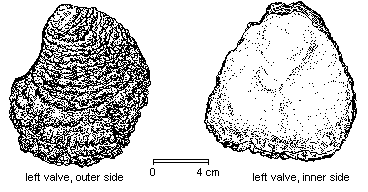
Ostrea edulis (Linnaeus, 1758)

Synonyms: Ostrea taurica Krynicki, 1837; Ostrea adriatica Lam.-Middendorff, 1848.
Common names: Engl: European flat oyster; Bulg: Stridia; Rom: Stridie; Russ: Ustritsa; Turk: Istiride.
Order (Scientific): CYRTODONTIDA.
Family (Scientific): OSTREIDAE.
Taxonomic descriptions: Shell moderately light, irregularly ovate, without a distinct hooked beak; patterned with delicate foliation and yellowish-brown in colour. Outline of both valves identical; left valve (fixed to the substrate) slightly cupped, with corrugated borders; right valve flat and marked with inconspicuous radiating folds. Shell consist of a series of chalky layers which may include laminar, hollow chambers. Size: maximum length - 80 mm; width - 26 mm.
 IUCN
Status:
IUCN
Status:
World level:
Black Sea Regional level: EN
Subregion level: EN (Romanian and Ukrainian sector), VU (Romanian sector)
Distribution: Mediterranean and Black Seas, Atlantic coast of Europe up to the Norwegian coast. Introduced to the Atlantic coast of USA. In Ukraine the largest colonies remaining in Donuzlav, encountered near Tarkhankut Cape, South Crimean coast (Laspi Bay, near Sevastopol, Sudak and Kara-Dag). Near the Caucasian shores - Bolshoi Utrish Cape.
Habitat type, Critical habitats, Limiting factors: Oxygen deficiency, siltation of habitats, rising turbidity and pollution of water.Scavenged by Rapana thomasiana. Uncontrolled catch.
Biology: Sedentary sestonophage. The left shell attaches to the substrate. Feeds on detritus, phyto- and bacterioplankton. Fertilization in mantle cavity. Fertility - 800 000 - 900 000 eggs. Planktonic larvae develop in 8-14 days.
Population trends: Valuable commercially up till the 1970s. Towards the end of the 1970s, the range decreased and the abundance of oysters drastically declined. By 1985 the species had completely disappeared in Dzarylgachsky (52,000,000 individuals in 1979) and Karkinitsky bays (207,000,000 - 1,766,000,000 individuals in 1979).
Threats:
Conservation measures taken: Catching prohibited. Included in the Red Data Book of Ukraine.
Conservation measures proposed: Conservation of remaining populations. Organization of sea farms and breeding grounds for receiving spat. Reduction in Black Sea coastal zone pollution.
References:
Compiled by: M.-T.Gomoiu, A.Petranu, E.Kolodkovskaya, V.Gubanov.